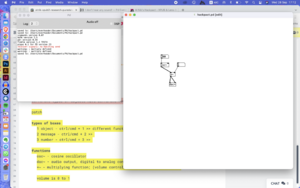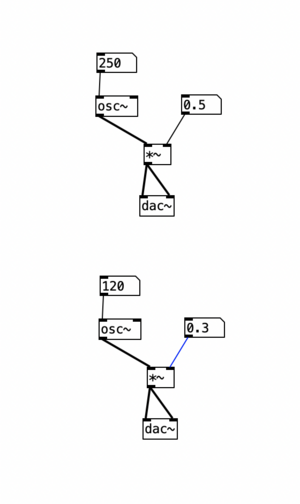Al Nik's Hackpact: Difference between revisions
No edit summary |
|||
| Line 77: | Line 77: | ||
[[File:Osc info.png|thumb]] | [[File:Osc info.png|thumb]] | ||
[[File:Pure data osc x2.png|thumb]] | |||
'''creating a simple oscillator with pure data - process log''' | '''creating a simple oscillator with pure data - process log''' | ||
Revision as of 20:36, 28 September 2022
_about
it's just a toy! - bruno
here are several research & experiments hackpacts to start with ⟿
_[audiozines]
[format] playing with audiozines as focus on format rather than on a topic.
[wip pad] is here
[process log]
research - i became quite interested in zines as a format and since we're experimenting with audio a lot, the combo looks like a good starting point for me. Started with a small research. (more details in the pad)
timeline
_1970-1980s - audio cassettes
_1997+ - compact discs (becoming more hybrid, + image and video)
_2000s - web based; podzines (ipods; downloadable)
_2010s - becoming podcasts
main characteristics
_small scale content
_analog turned digital through tech development
_notion of limitation - in length, in size, in accessibility
_often come in series
_radical, anarchistic content (now)
_independent publishers (now)
_spoken words
_non-fiction content, but often connected to science fiction pieces (at least for a few decades)
_curated, conceptual content
_DIY culture
why interesting in audiozines?
_DYI and independent publishing notion
_limitations - in terms of length, accessibility, distribution - small scale contents
_conceptual (curated, but raw)
_connection to analog - audio cassette origins
_connection with print zines - can have it's own printed zine edition as well
_[pure data]
[format] experiment with focus on format (instead of topic). First baby steps in getting to know Pd.
[work] with Mitsa
[wip pad] is here
[process log]
research - for the experiment, i have researched a bit what pure data is and what tutorials we can use to start. As Mitsa and i are interested in creating sounds, music, edit audio with it, i proposed us to try the tutorials created by Australian artist and educator Andrew R. Brown.
He has published a series of 53 video tutorials for getting to use Pure Data for Real-time music and sound.
creating a simple oscillator with pure data - process log
1_ download pure data vanilla - here 2_ create a new patch 3_ create the following boxes: object box with osc~; object box with audio output (digital to analog converter); object for defining the volume - object box with multiplying function and number box to define the volume number; finally, a number box to adjust the osc frequency. 4_ connect them with sound on to hear the osc sound. 5_ add another one and play with frequencies.
why interested in pure data?
as part of the master project research, we (Mitsa and Alex) are looking for various methods and tools to collect and edit sound and music. What we like about pure data is its visual interface and mapping style. It is also a way to build complex pieces and mix already existing audio with newly programmed sounds. It is a free software, independent; also new to us both.



